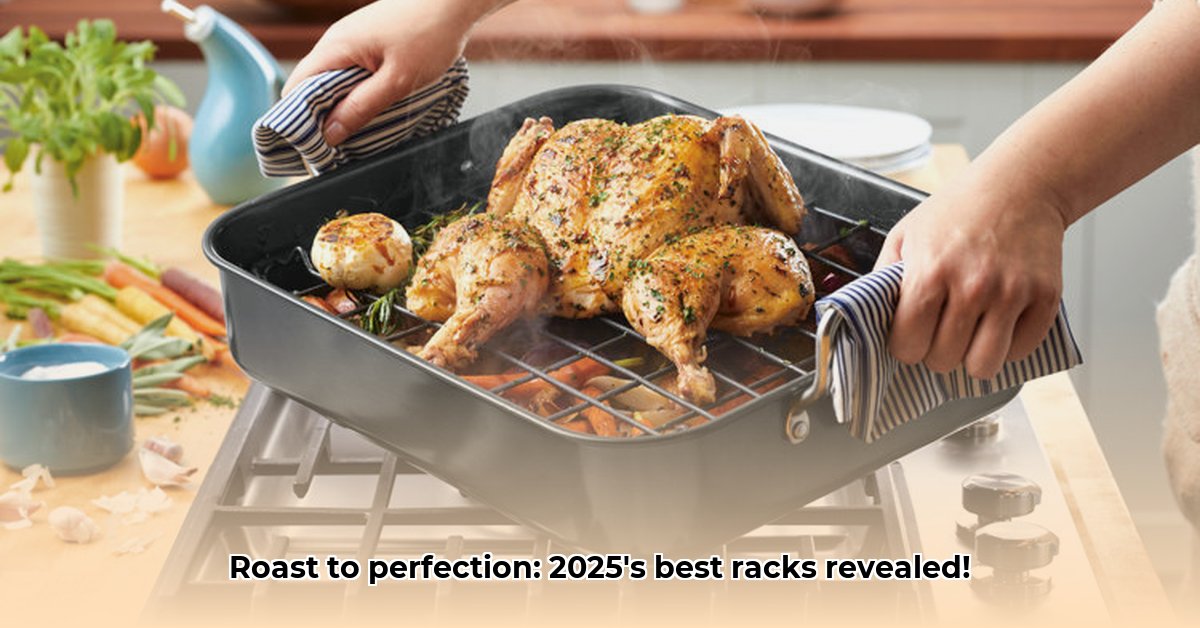Roasting pans are essential for creating delicious meals, but achieving perfectly cooked results can be challenging if your food cooks unevenly or sticks to the bottom. A roasting pan rack is the solution! Whether you’re a seasoned chef or just beginning your culinary journey, this comprehensive guide will help you discover the ideal rack for your needs. We’ll explore various rack materials, including stainless steel, cast iron, and non-stick options, highlighting their unique advantages and disadvantages. You’ll learn how to choose the correct size to ensure proper airflow and discover essential cleaning techniques to maintain your rack’s longevity. Prepare to unlock the secrets to consistently juicy, evenly cooked roasts!
Roasting Pan Rack: Your Secret Weapon for Perfect Roasts
Achieve perfectly cooked meats and vegetables with even heating
Nobody wants a roast that’s burnt on the outside and raw in the middle. A roasting pan rack elevates your food, allowing hot air to circulate evenly and prevent the bottom from becoming soggy. This guide will help you master the art of using a roasting pan rack, transforming your roasts from ordinary to extraordinary.
Picking the Perfect Rack: Material Matters
The material of your roasting pan rack significantly impacts its performance and durability. Consider these factors when choosing:
Stainless Steel: Stainless steel racks are known for their exceptional durability and resistance to rust. They’re also relatively easy to clean, often requiring just a quick scrub with soap and water. While stainless steel may not distribute heat as evenly as cast iron, it’s a reliable choice for everyday roasting.
Cast Iron: Cast iron is the heavyweight champion of heat retention, making it ideal for achieving a beautifully browned exterior. Its ability to maintain high temperatures ensures even cooking and a crispy crust. However, cast iron racks are heavy and require seasoning to prevent rusting. They also need to be hand-washed.
Non-Stick Coated: Non-stick coated racks offer the convenience of easy food release and quick cleanup. These racks are perfect for those who value a low-maintenance option. However, the non-stick coating can be prone to scratching over time, potentially shortening the rack’s lifespan.
Finding the Right Fit: Size Does Matter
Maximize airflow with properly sized Roasting Pan Rack
Before purchasing a rack, measure your roasting pan’s interior dimensions. A rack that’s too small restricts airflow, leading to uneven cooking and sticking. A rack that’s too large might not fit properly, creating an unstable surface. Aim for a rack that’s slightly smaller than your pan’s dimensions, leaving enough space for proper air circulation.
Here’s a general guideline for selecting the right rack size:
| Approximate Roasting Pan Dimensions | Recommended Rack Dimensions (approx.) |
|---|---|
| 12×17 inches | 11×16 inches |
| 15×21 inches | 14×20 inches |
| 18×26 inches | 17×25 inches |
Always refer to the manufacturer’s specifications to ensure a perfect fit.
Design Details: The Little Things That Make a Big Difference
Elevated legs and handles improve Roasting Pan Rack functionality
Consider these design elements when choosing a roasting pan rack:
-
Elevated Legs: These are essential for lifting your food above the pan’s surface, promoting air circulation and even cooking.
-
Handles: Handles offer a safer and more convenient way to lift a hot rack out of the pan.
Cleaning and Care: Keeping Your Rack in Top Shape
Proper cleaning extends the life of your Roasting Pan Rack
Regular cleaning helps maintain your rack’s hygiene and extends its lifespan. Follow these cleaning guidelines based on the rack’s material:
Stainless Steel: Wash with warm, soapy water and a non-abrasive sponge or pad.
Cast Iron: Hand-wash only and re-season as needed to maintain its non-stick properties.
Non-Stick Coated: Hand-wash gently to avoid scratching the coating and avoid abrasive cleaners.
Pro Tip: Soaking the rack in hot, soapy water before cleaning can loosen stubborn food particles. The hot water penetrates and softens baked-on residue, while the soap breaks down grease and oils. This combination makes scrubbing easier and more effective.
Price Points: Something for Every Budget
Roasting pan racks are available at various price points. Budget-friendly options (under $20) are ideal for occasional roasters. Mid-range racks ($20-$50) offer increased durability and features. High-end models ($50+) are constructed with premium materials for superior performance and longevity.
Roasting 101: A Step-by-Step Guide
Proper use ensures best results with your Roasting Pan Rack
Follow these steps to achieve the best results when using your roasting pan rack:
-
Preheat your oven: Preheat the oven to the temperature specified in your recipe to ensure even cooking.
-
Prepare your food: Season and arrange your meat or vegetables on the rack, ensuring they aren’t overcrowded.
-
Place the rack in your pan: Make sure the rack sits securely and doesn’t wobble.
-
Roast: Follow your recipe’s cooking time and temperature instructions carefully.
-
Check for doneness: Use a meat thermometer to verify that your food has reached the safe internal temperature.
Beyond the Roast: Recipe Inspiration
Roasting Pan Racks elevate various meals from roasted chicken to sheet pan dinners
A roasting pan rack can be used for more than just roasts. Explore these culinary possibilities:
-
Roasted Vegetables: Achieve perfectly caramelized and tender vegetables.
-
Roasted Chicken: Create crispy skin and juicy meat with minimal effort.
-
Sheet Pan Dinners: Prepare complete meals on a single pan for easy cleanup.
Choosing the right roasting pan rack depends on your cooking style, preferences, and budget. By considering the factors outlined in this guide, you’ll be well on your way to creating consistently delicious roasts and other oven-baked dishes. Happy roasting!
How to Choose the Best Roasting Pan for Even Cooking and Different Budgets
Understanding how key factors influence Roasting Pan Rack selection
Key Takeaways:
- Roasting pan racks promote even cooking by allowing air to circulate around the food.
- Material choices (stainless steel, cast iron, non-stick) affect performance, cleaning, and durability.
- Accurate rack size ensures optimal airflow and stability.
- Features like elevated legs and handles enhance convenience and safety.
- Roasting pan racks are available at a wide range of prices.
Choosing the Right Roasting Pan Rack: A Step-by-Step Guide
Methodically selecting the ideal Roasting Pan Rack based on individual needs
Selecting a roasting pan rack should be a thoughtful process. Consider the following steps:
-
Measure your roasting pan: Measure the interior dimensions of your roasting pan for a precise fit.
-
Consider your cooking style: Think about how often you roast and the types of food you prepare.
-
Assess your budget: Determine how much you’re willing to spend on a rack.
-
Choose your material:
- Stainless Steel: Offers durability, even heating, and dishwasher-safe convenience.
- Cast Iron: Provides exceptional heat retention and even cooking.
- Non-Stick: Simplifies cleanup and is ideal for delicate foods.
-
Check for key features: Look for elevated legs for airflow and handles for easy handling.
Roasting Pan Rack Materials: Pros and Cons
Analyzing the advantages and disadvantages of various Roasting Pan Rack options
| Material | Pros | Cons |
|---|---|---|
| Stainless Steel | Durable, even heating, dishwasher safe, resists rust | Can be more expensive, may not be as non-stick as others |
| Cast Iron | Excellent heat retention, even cooking, creates crispy crust | Heavy, requires seasoning, not dishwasher safe, can rust |
| Non-Stick | Easy cleanup, ideal for delicate foods, prevents sticking | Less durable than steel or cast iron, coating can scratch |
Using Your Roasting Pan Rack: Tips and Tricks
Expert tactics to maximize effectiveness of your Roasting Pan Rack
- Proper placement: Arrange food evenly on the rack to ensure even airflow.
- Don’t overcrowd: Avoid overcrowding the rack to allow for maximum air circulation.
- Use a meat thermometer: Check the internal temperature of meats to ensure they’re cooked to a safe temperature.
- Preheat your oven: Preheating the oven ensures consistent cooking temperatures.
- Rest your roast: Allow the roast to rest for 10-15 minutes before carving to retain juices.
- Clean promptly: Clean the rack soon after use to prevent food from sticking.
- Gray Kitchen Backsplash Tile: Ideas for a Stylish Upgrade - December 14, 2025
- Backsplash For Gray Cabinets: Choosing the Right Backsplash Style - December 13, 2025
- Gray And White Backsplash: Ideas For Timeless Style - December 12, 2025









